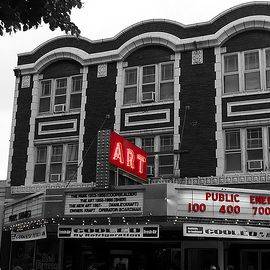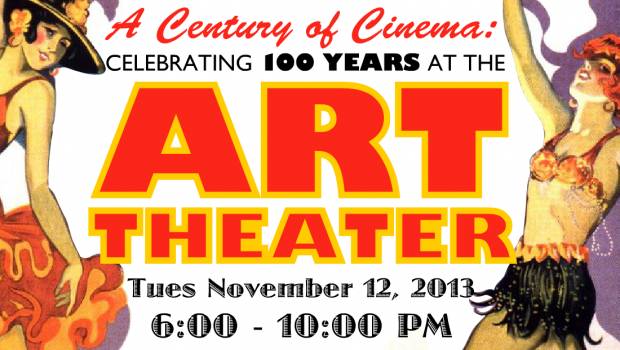
Let me tell you a story.
A man stands on the sidewalk, in the shadow of a moviehouse marquee. He takes in the “Now Showing” posters, encased behind glass. There is an old-fashioned ticket booth, unoccupied at this moment, but full of history. It is redolent of another time. He opens the door to the lobby and finds the patterned carpet, the light and heat of a concession area, the sound and smell of popcorn.
This is not the story. Not yet.
He pays for his ticket, gets a snack, and makes his way into the auditorium. There he surveys his seating options, one seat as good as the next. He picks his spot, listens to the piped-in music, and watches the screen as a slideshow displays photographs of the building from various angles and in different seasons. There is something friendly in these images. Familiar—almost familial. In this space, with its bygone-era lighting fixtures and too-loud heating system. Shabby-chic, but the good kind. Lived-in. There is something quaint and homemade and so very comfortable.
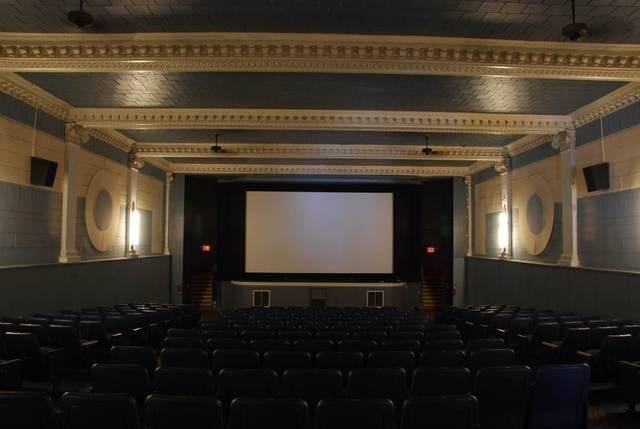
They don’t make ’em like this anymore, he thinks.
The audience fills in around him, people chattering about their day, about their night, about the film about to start. The seats fill up, the temperature in the room rises, and the minutes tick down to showtime.
This is not the story. Not yet.
Before the movie starts, another man strides down the aisle to stand in front of the screen. A bespectacled, bearded fellow with a lot of energy, he welcomes the audience and introduces the film they’re all about to see. Finally, when the introduction has ended, when the heaters have been turned off, and when the lights have dimmed, the screen comes to life.
Now the story begins. Because the building—for all its charm, for all its history—is not the story. The story, of course, is up on the screen.
********
I have attended so many films at the Art in the last few years. Not as many as I would have liked, but then I didn’t grow up around here. I don’t remember the first time I entered its little throwback of a lobby, but I know intimately the warmth and texture of the room.
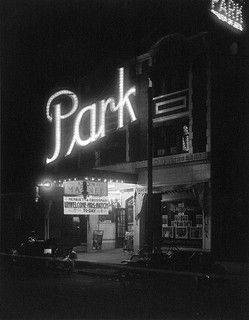 I can’t speak eloquently to the history of the Art Theater, first known as the Park. Luckily, I don’t have to. All one needs to do to educate him- or herself about the building’s past and transformation is to visit the Art’s website. There is a lovely account there by local theater historian Perry C. Morris that is both thorough and entertaining.
I can’t speak eloquently to the history of the Art Theater, first known as the Park. Luckily, I don’t have to. All one needs to do to educate him- or herself about the building’s past and transformation is to visit the Art’s website. There is a lovely account there by local theater historian Perry C. Morris that is both thorough and entertaining.
What I can speak to, personally, is the unambiguous thrill of sitting in that wide, warm room, looking down front at the screen and watching films I could not have otherwise seen. Having experiences I might otherwise not have had.
The House I Live In, Rust and Bone, John Dies at the End, Searching for Sugar Man, To the Wonder, Cloud Atlas, Vertigo, Weekend, The Sapphires, Joss Whedon’s Much Ado About Nothing… Not only did all of these films play at the Art in 2013, but they are just the ones I personally saw that I can remember off the top of my head. How many late night movies did I miss? How many stunning independent films or daring documentaries?
In addition to the Art’s impressive run of features, consider its roster of local events: Pens to Lens, the New Art Film Festival, Reel It Up, The Latin American Film Festival, Dangerous Docs, and local premieres like Scary Normal and House of Thaddeus. Where else are you going to see all of this? Who else will open its doors to the community in such a way? And I haven’t even mentioned the screenings of professional plays from the National Theatre of London, beamed around the world and into our town, affording us yet another entertainment opportunity.
 The Art has gone through its share of changes over the years, from moviehouse to”adult” venue to, currently, the nation’s only cooperatively owned independent movie theater. The keys to the doors have changed hands a few times between 1913 and today, but as the Art prepares to celebrate its 100th anniversary, it could not be in better hands than those of general manager Austin McCann. (He’s the bearded fellow I described earlier.)
The Art has gone through its share of changes over the years, from moviehouse to”adult” venue to, currently, the nation’s only cooperatively owned independent movie theater. The keys to the doors have changed hands a few times between 1913 and today, but as the Art prepares to celebrate its 100th anniversary, it could not be in better hands than those of general manager Austin McCann. (He’s the bearded fellow I described earlier.)
McCann’s enthusiasm for movies, for the local C-U community, and for the Art Theater is hard to miss. I was fortunate enough to speak with him recently about his work with this local landmark, and I’m thrilled to share that conversation with you.
********
Smile Politely: What do you consider the mission of the Art to be? What is its importance to the community?
Austin McCann: The “Ends” of the Art Theater Co-op—our vision of what we want the Art to achieve—include:
- The Art Theater Co-op is a vibrant and welcoming community.
- Audiences new and old enjoy a classic cinema experience.
- The engaged audience for art house cinema is cultivated and increased.
- Local filmmakers find an audience.
- The art house cooperative movement is strengthened.
These are Ends that the Board arrived at after much discussion and input about what makes the Art a special place, why people like to come to our theater, and why they’d want to become owners in our co-op. My job, as GM, is to realize these goals through the day-to-day operations of the theater.
In terms of community, I know that the Art matters because we’re the only movie institution that has its roots in the community, not only through community ownership but through conversation. People who come to the Art come because we’re “different.” That’s what they say. They want a place to see good movies with good people. And good popcorn and beer! Then have good conversations afterward. There’s nothing national or impersonal about the Art. You have me fulfilling the Co-op’s vision based on the direct input of those who are affected by us. It’s a really democratic and intelligent system we have.
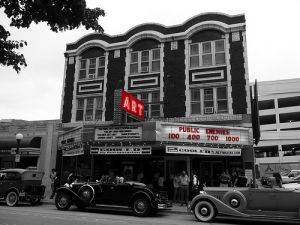 SP: Of all the various types of films you show, are there any you particularly enjoy bringing to the community?
SP: Of all the various types of films you show, are there any you particularly enjoy bringing to the community?
McCann: I love to see happy audiences, so in some sense it doesn’t matter what the film is. But it’s part of our Ends and a personal priority of mine to show certain kinds of films—especially new and unusual ones. It’s most rewarding to show something that is really aesthetically and socially powerful but couldn’t find a home anywhere else. I’m thinking of films like Mother of George, This Is Not A Film, Beyond the Hills, Short Term 12, Sister, Tabu, and others. These have smaller audiences right now, but I also believe that that’s our magic spot. And I love to connect with people after screening movies like those.
SP: I’ve wondered for a while know: what determines which films you show? Why, for example, Enough Said rather than another indie film?
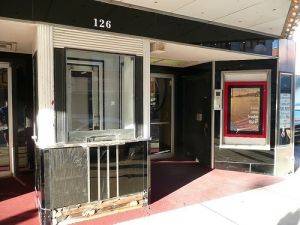
McCann: It’s not so hard to know what our audiences want to see (although actually getting them is a hard process). The vast majority of our audiences are drawn to the same things “mainstream” film audiences are: well-known actors, story lines they feelthey can relate to, and whether or not they’ve heard about it. This was surprising to me at first, and it might surprise some of those audience members to see it laid bare. But that’s the reality. So, Enough Said was an easy choice. Even aside from the fact that it’s a good film, most importantly it stars well-known actors, got great reviews and solid press—mostly because it’s distributed by a big distributor who can afford mass marketing. Big movies like those keep us afloat. Our audiences do have distinguishing characteristics, though: they care about critics’ reviews, which is a good thing. They’re also not afraid of controversial films, so we can happily play films rated NC-17, for example. Now, there’s also a small, loyal vanguard part of the audience who really read about the films I program and come out to see the smaller films, the more experimental or unfamiliar films. Those are the people I most enjoy programming for, because then I can use my own aesthetic criteria for what to show, and in that case I just pick the films that seem to move the art of cinema forward and offer something special to their audience. Obviously Late Night programming is a whole different matter, but that one, too, involves learning what makes our audience tick, so to speak. We’ve been wrong a number of times about what people want to see.
SP: Is there a classic film you haven’t shown yet but would love to?
McCann: There are so many! I really love older cinema; it’s what got me interested in the art form back in high school. Bicycle Thieves, 2001: A Space Odyssey, Murnau’s Sunrise, any Italian neorealist movie. Film noir is very near and dear to my heart. We got to play a 35mm of The Night of the Hunter last fall, which was a dream come true. And now with DCP restorations, there’s a whole new score of films out there to play. I like to keep my eye on Janus Films, Rialto Pictures, and others to see what they’re restoring. This year we got to play restored prints of Eraserhead and The Wicker Man, which was thrilling to all of us.
SP: What sorts of non-movie events have taken place at the Art over the years? Are there any other types of events you envision happening in the future?
McCann: This past year, we had a live comedy event called Words & Pictures where comedians performed and used our digital projector creatively. We also had some great local bands play along to sections of films—that one was called Sound & Light. We have a lot of panels and discussions at the Art. It’s a pretty limited space because we don’t have much in the way of fancy lighting or a stage, but we still manage to make the space come beautifully alive using what we have.

SP: Just out of curiosity, is the co-op doing well? Is the theater looking for more owners?
McCann: We always want more owners. The more owners we have, the more invested we are in the community—and the more the community is invested in us. It really matters. It’s not just financial, although having a large equity base is really important for keeping our business afloat. And yes, we’re doing well in a lot of ways. I think we’ve built a few different audiences this past year through creative programming and special events. I think the space feels more alive and creative and engaging than it has felt. But we’re also in a uniquely difficult position as a single-screen indie movie theater competing in an economy that favors scale and familiarity, as well as quantity-over-quality. We’re old-school in a lot of ways, and our audience definitely gets that and wants that. At the same time, I think folks aren’t always aware of how hard it is to run an art-house cinema. For example, just securing a movie like Enough Said can involve months of wrangling and a tremendous amount of risk. And there are weeks where we aren’t able to get any well-known films, so we just play amazing (I want to emphasize) lesser-known films, but the audience isn’t quite there for those just yet, and that’s what we really need to do if we want to flourish in the long run. We need to build an audience that seeks out the unfamiliar, the new. That’s how our being a co-op can help – we have a loyal base of audience members on hand who want us to realize our vision and feel responsible for being part of it.
********
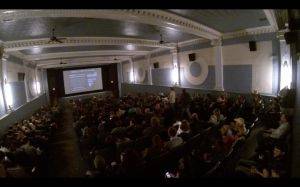
On Tuesday, November 12, at 6:00 p.m., the Art will celebrate its golden anniversary with the world premiere of The Art Lives, a short documentary film about the history of the Art. The film, produced by Luke Boyce of Champaign-Urbana’s Shatterglass Studios, will be followed by a panel discussion with historians about the Art’s storiedpast and evolution. There will also be discussion of a new book entitled The Art Theater: Playing Movies for 100 Years with its authors—Perry C. Morris, Joseph Muskin, and Audrey Wells.
Dressing in the style of “Old Hollywood” is encouraged for this event, and there will be a costume contest.
At 8 p.m., a specially commissioned music piece by Andrew Alden Ensemble will accompany a collection of classic shorts.
Tickets for the event are available here, either for the entire evening’s festivities or just for the 8 p.m. event with the Andrew Alden Ensemble.
For more information about this tremendous undertaking, be sure to visit the Art website. For that matter, visit the site just to find out what great film is headed our way next. Then stand in the shadow of the marquee. Meet some friends and go into the lobby. Smell the popcorn. Order a drink. Find a seat.
Let them tell you a story.








